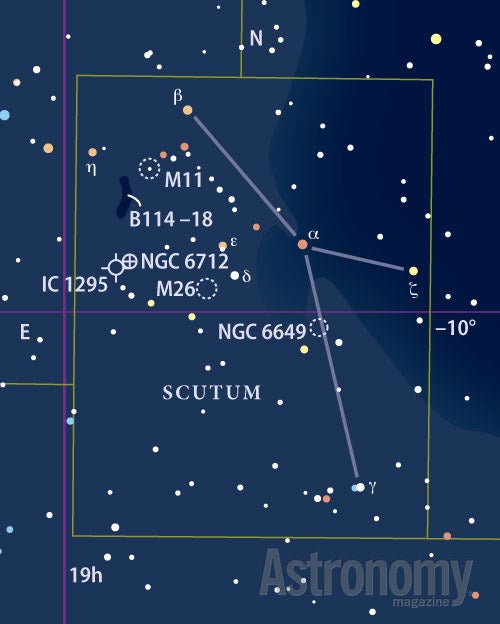Targets for August 13–20, 2015
Small telescope:
Open cluster NGC 6633
Small telescope:
Dark nebulae Barnard 114–118
Large telescope:
Globular cluster M54
This week’s first small-telescope target is the Captain Hook Cluster, also known as the Wasp-Waist Cluster and NGC 6633. It’s an open cluster in northern Ophiuchus.
Yet although this object sits in Ophiuchus, the easiest way to find it is to look 7.6° west-northwest of magnitude 4.6 Alya (Theta [θ] Serpentis). Because magnitude 4.6 NGC 6633 lies in an incredibly rich star field, you’ll have to be both sharp-eyed and patient to spot it without optical aid, but it is possible.
The cluster lies only 1,000 light-years away, so it’s huge (as big as the Full Moon), and many of its stars are bright. Through a 4-inch telescope, more than a dozen of them outshine 10th magnitude. That group appears to sit in front of an additional 50 fainter stars. If you use larger-aperture instruments, keep the magnification around 100x so you don’t disperse the stars so much that you look “through” the cluster.
The brightest nearby star is SAO 123516, which lies 0.4° south-southeast of NGC 6633. Note the tight clump of magnitude 8.5 to 10.5 stars at the cluster’s eastern edge.
Astronomy magazine Contributing Editor Stephen James O’Meara gave this cluster both of the common names I mentioned. He called it the Captain Hook Cluster because, to him, the main form appears hook-shaped. If, however, you see the hook’s thin shaft as the waist of a wasp whose wings are the perpendicular row of stars at the cluster’s northeast end, then, to him, it becomes the Wasp-Waist Cluster.
Hiding the stars behind it
I chose this week’s second small-scope object not because it emits light, but rather because this complex of dark nebulae in Scutum blocks it.
To find this region, point your 6-inch or larger telescope 1.8° south-southwest of magnitude 4.8 Eta (η) Scuti. Alternatively, you can find its northern edge 0.5° southeast of the Wild Duck Cluster (M11). From there, the darkness drifts southward and westward for some two Full Moon widths.
In this area, you’ll encounter more than a half-dozen individual clouds cataloged by American astronomer Edward Emerson Barnard, including Barnard 112 — abbreviated B112 — B114, B115, and B118. Best results come through telescope/eyepiece combinations that yield approximately 75x.
A southerly globular
This week’s large-telescope target is globular cluster M54 in Sagittarius. It lies 1.7° west-southwest of magnitude 2.6 Ascella (Zeta [ζ] Sagittarii).
Although its total magnitude — 7.6 — is bright, only the largest amateur telescopes resolve M54’s stars. That’s because it lies 87,000 light-years away, making it the most distant globular cluster in French comet-hunter Charles Messier’s famous catalog. Its brightest stars shine at only magnitude 15.5.
M54 is 9.1′ in diameter. That corresponds to an area a bit more than 8 percent as large as the Full Moon. Through an 11-inch telescope, M54’s center appears broad and bright. A razor-thin halo surrounds it, but you’ll need to crank up the magnification past 350 to see it.
Expand your observing at Astronomy.com
StarDome
Check out Astronomy.com’s interactive StarDome to see an accurate map of your sky. This tool will help you locate this week’s targets.
The Sky this Week
Get a daily digest of celestial events coming soon to a sky near you.
Observing Talk
After you listen to the podcast and try to find the objects, be sure to share your observing experience with us by leaving a comment at the blog or in the Reader Forums.











